Influence Mechanism of a Bridge Wind Barrier on the Stability of a Van-Body Truck under Crosswind
Abstract
:1. Introduction
2. Aerodynamic Truck Model and Validation
3. Influence and Analysis of Wind Barriers on the Truck’s Aerodynamic Characteristics
4. Verification by the Wind Tunnel Test
5. Influence and Analysis of Wind Barrier on the Truck’s Driving Stability
6. Discussion and Results
- (1)
- A quantitative evaluation method of bridge wind barriers is proposed based on the coupling method of vehicle aerodynamics and multi-body dynamics, which can comprehensively evaluate the influence of bridge wind barriers on the aerodynamic performance and crosswind stability of vehicles and provide a reference for the selection of wind barriers and the design of structural parameters. The method with quantitative analysis can obtain better porosity and height of the wind barriers, which can meet the requirements of wind-induced traffic safety on bridges and reduce the structural safety hazards of bridges caused by the retrofitting of wind barriers.
- (2)
- The wind barrier height and porosity are the key parameters affecting the bridge deck wind speed and the effective shelter height. The average wind speed decreases with decreasing porosity, and the effective shelter height increases as the porosity decreases when the wind barrier height is determined; the average wind speed at the bridge deck decreases with increasing wind barrier height, and the effective shelter height increases with increasing wind barrier height for a given wind barrier porosity;
- (3)
- The aerodynamic side force is sensitive to wind barrier porosity and height change. After the installation of wind barriers, the aerodynamic side force of the van-body truck decreases significantly. It decreases with the increase in wind barrier height and the decrease in wind barrier porosity; variations in the porosity and height of the wind barriers lead to irregularities in the wind speed near the bridge’s ground and the aerodynamic lift of the van truck;
- (4)
- The aerodynamic side force is a crucial parameter to determine the crosswind stability of the van truck. After adding the wind barrier, the straight-line driving stability of the van is significantly improved. The lateral acceleration, yaw velocity, and lateral displacement decrease with increasing height of the wind barrier, and with decreasing porosity of the wind barrier.
Author Contributions
Funding
Informed Consent Statement
Data Availability Statement
Acknowledgments
Conflicts of Interest
References
- Zhu, L.D.; Li, L.; Xu, Y.L.; Zhu, Q. Wind tunnel investigations of aerodynamic coefficients of road vehicles on bridge deck. J. Fluids Struct. 2012, 30, 35–50. [Google Scholar] [CrossRef]
- Zhang, Q.; Su, C.; Zhou, Y.; Zhang, C.; Ding, J.; Wang, Y. Numerical investigaion on handing stability of a heavy tractor semi-trailer under crosswind. Appl. Sci. 2020, 10, 3672. [Google Scholar] [CrossRef]
- Elvik, R.; Sagberg, F.; Langeland, P.A. An Analysis of Factors Influencing Accidents on Road Bridges in Norway. Accid. Anal. Prev. 2019, 129, 1–6. [Google Scholar] [CrossRef] [PubMed]
- Dorigatti, F.; Sterling, M.; Rocchi, D.; Belloli, M.; Quinn, A.D.; Baker, C.J.; Ozkan, E. Wind tunnel measurements of crosswind loads on high sided vehicles over long span bridges. J. Wind Eng. Ind. Aerodyn. 2012, 107, 214–224. [Google Scholar] [CrossRef]
- Yuan, Z.; Gu, Z.; Wang, Y.; Huang, X. Numerical investigation for the influence of the car underbody on aerodynamic force and flow structure evolution in crosswind. Adv. Mech. Eng. 2018, 10, 1687814018797506. [Google Scholar] [CrossRef]
- Kozmar, H.; Procino, L.; Borsani, A.; Bartoli, G. Sheltering efficiency of wind barriers on bridges. J. Wind. Eng. Ind. Aerodyn. 2012, 107, 274–284. [Google Scholar] [CrossRef] [Green Version]
- He, X.; Xue, F.; Zou, Y.; Chen, S.; Han, Y.; Du, B.; Xu, X.; Ma, B. Wind tunnel tests on the aerodynamic characteristics of vehicles on highway bridges. Adv. Struct. Eng. 2020, 23, 2882–2897. [Google Scholar] [CrossRef]
- Zhan, K.; Lin, X.; Yang, Y.; Lian, J.; Hou, H.; Liu, G.; Hu, L.; Lin, L. Experimental research on wind resistance of bridge wind barrier under different structural parameters. J. Fuzhou Univ. 2021, 49, 217–224. [Google Scholar]
- Chen, N.; Li, Y.; Wang, B.; Su, Y.; Xiang, H. Effects of wind barrier on the safety of vehicles driven on bridges. J. Wind. Eng. Ind. Aerodyn. 2015, 143, 113–127. [Google Scholar] [CrossRef]
- Kozmar, H.; Procino, L.; Borsani, A.; Bartoli, G. Optimizing height and porosity of roadway wind barriers for viaducts and bridges. Eng. Struct. 2014, 81, 49–61. [Google Scholar] [CrossRef]
- Dong, Z.; Luo, W.; Qian, G.; Lu, P.; Wang, H. A wind tunnel simulation of the turbulence fields behind upright porous wind fences. J. Arid. Environ. 2010, 74, 193–207. [Google Scholar] [CrossRef]
- Wang, L.; Chen, X.; Chen, H. Research on wind barrier of canyon bridge-tunnel junction based on wind characteristics. Adv. Struct. Eng. 2021, 24, 870–883. [Google Scholar] [CrossRef]
- Wang, Y.; Guo, W.; Xia, H.; Zhang, N.; Zhang, T. Wind tunnel test of tri-component coefficients for a train-bridge system considering wind barrier effect. J. Vib. Shock 2018, 37, 88–94. [Google Scholar]
- Zhen, X.; Su, Y.; Xiang, H.; Li, Y. Influence of wind barrier on aerodynamic characteristics of vehicles on rail-cum-road bridge. Railw. Eng. 2018, 58, 25–30. [Google Scholar]
- Zhang, J.; Zhang, M.; Li, Y.; Huang, X.; Zheng, Z. Aerodynamics of high-sided vehicles on truss girder considering sheltering effect by wind tunnel tests. Balt. J. Road Bridge Eng. 2020, 15, 66–88. [Google Scholar] [CrossRef]
- Xiang, H.; Li, Y.; Chen, S.; Hou, G. Wind loads of moving vehicle on bridge with solid wind barrier. Eng. Struct. 2018, 156, 188–196. [Google Scholar] [CrossRef]
- Xue, F.; Han, Y.; Zou, Y.; He, X.; Chen, S. Effects of wind-barrier parameters on dynamic responses of wind-road vehicle–bridge system. J. Wind. Eng. Ind. Aerodyn. 2020, 206, 104367. [Google Scholar] [CrossRef]
- Nakashima, T.; Tsubokura, M.; Vazquez, M.; Owen, H.; Doi, Y. Coupled analysis of unsteady aerodynamics and vehicle motion of a road vehicle in windy conditions. Comput. Fluids 2013, 80, 1–9. [Google Scholar] [CrossRef] [Green Version]
- Chu, C.R.; Chang, C.Y.; Huang, C.J.; Wu, T.R.; Wang, C.Y.; Liu, M.Y. Windbreak protection for road vehicles against crosswind. J. Wind. Eng. Ind. Aerodyn. 2013, 116, 61–69. [Google Scholar] [CrossRef]

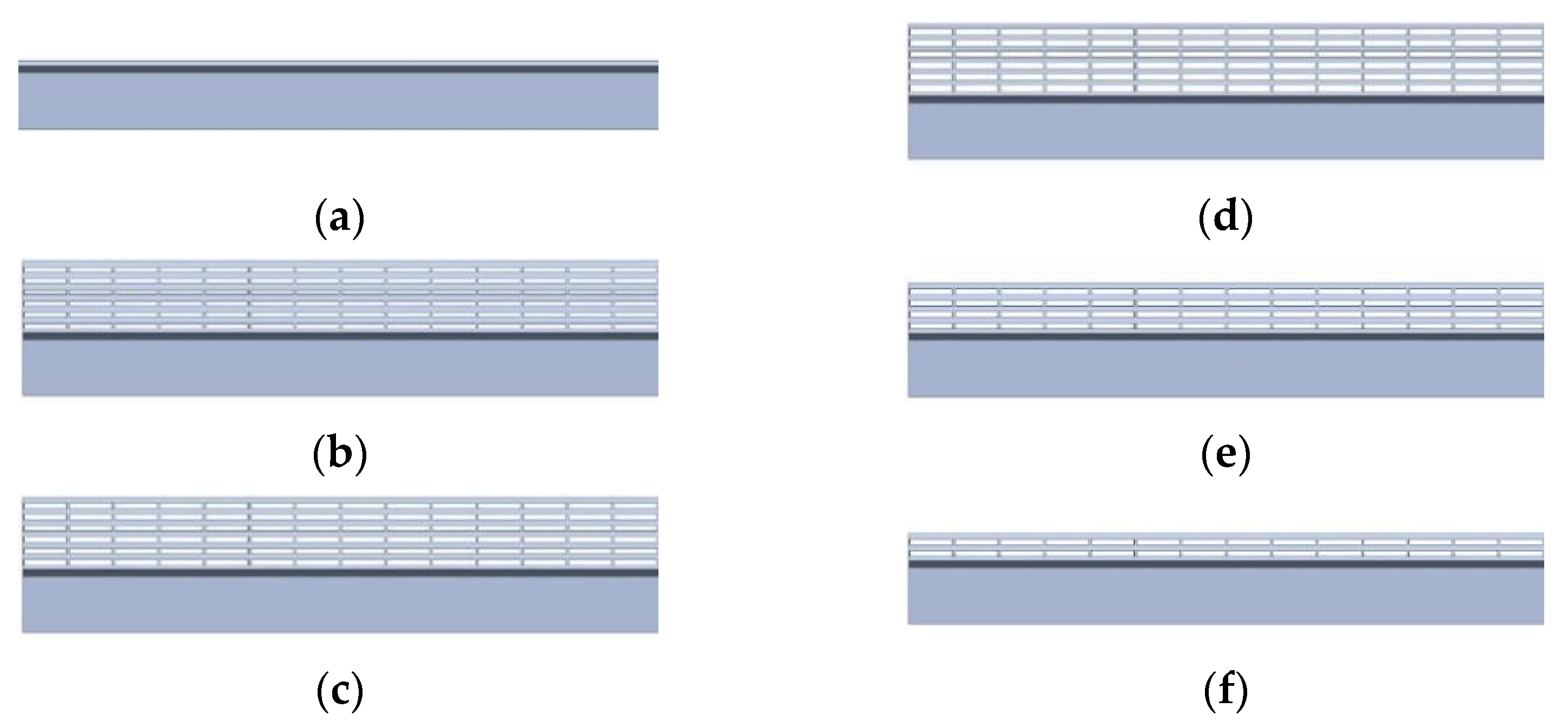

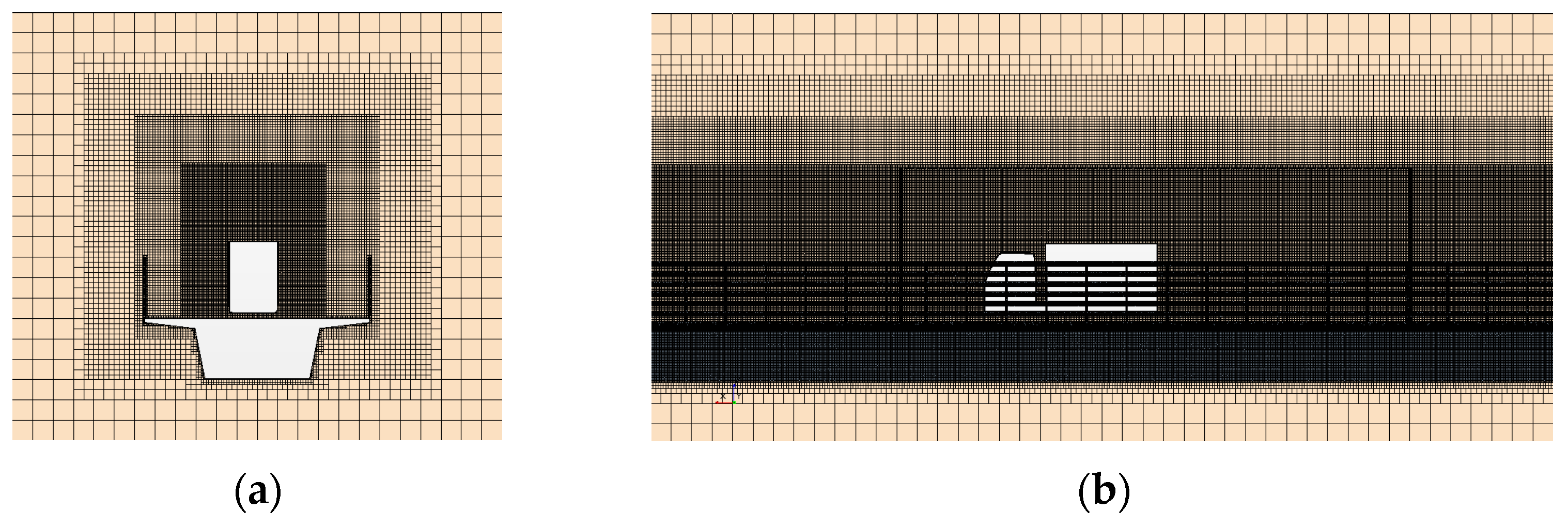
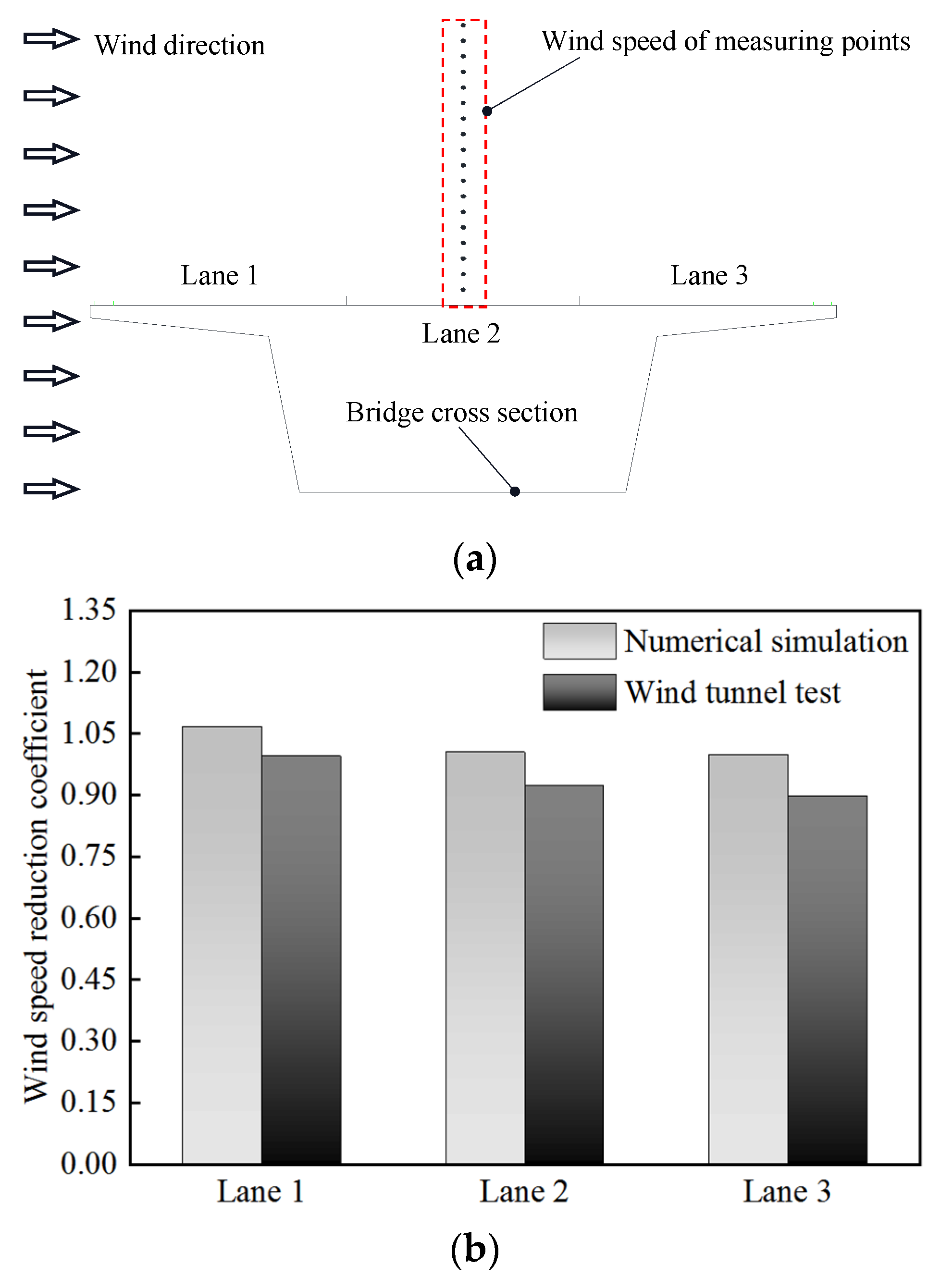

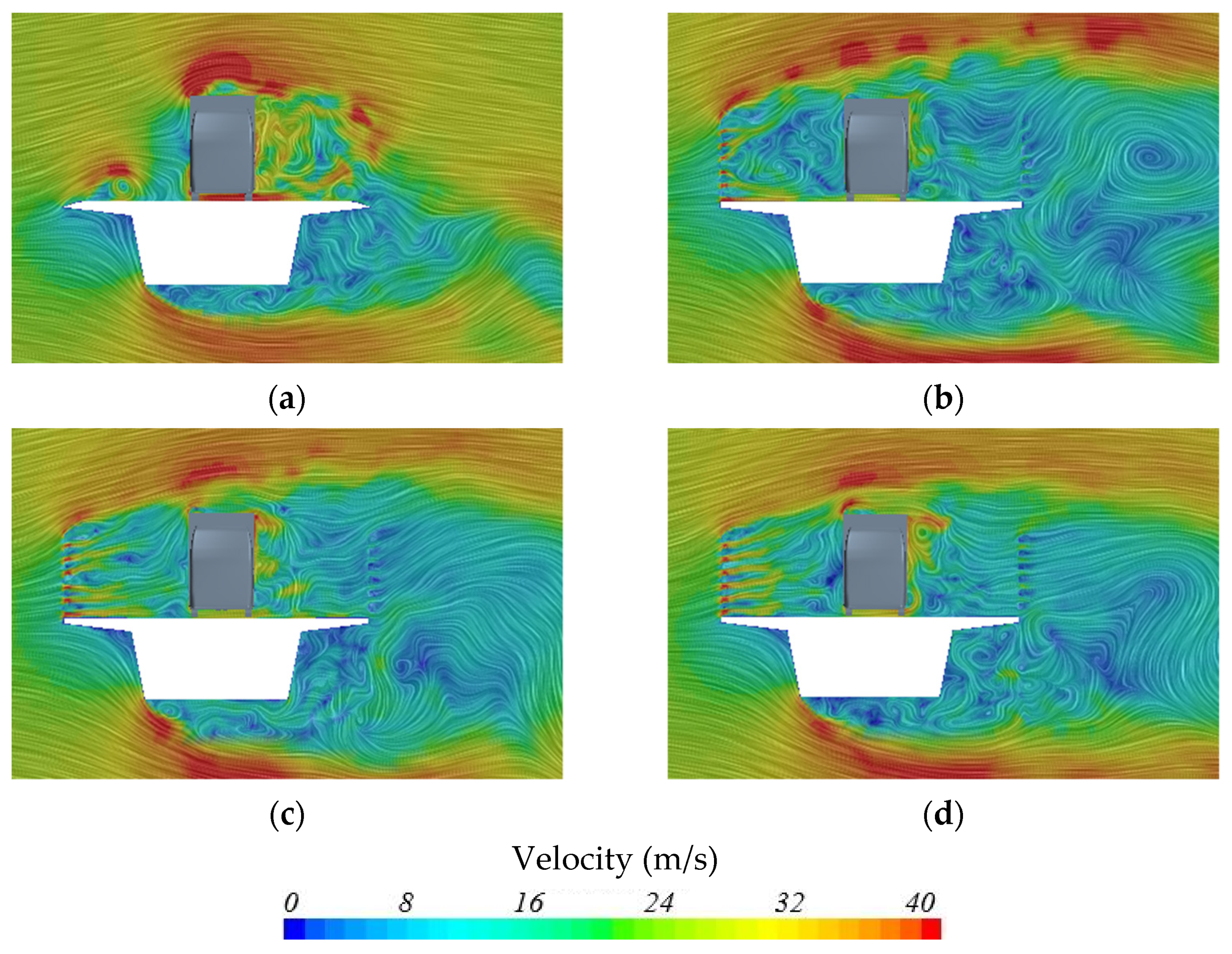
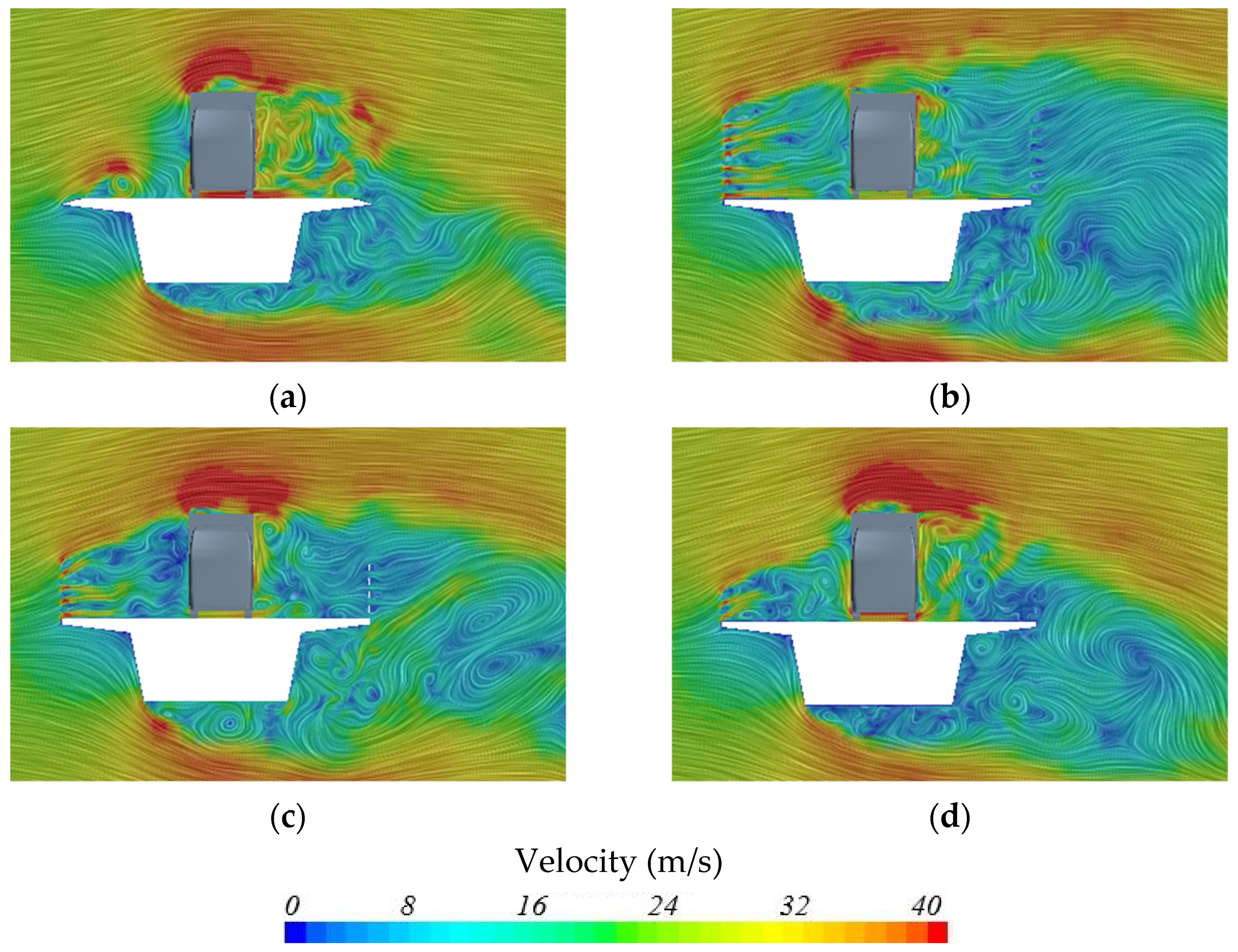
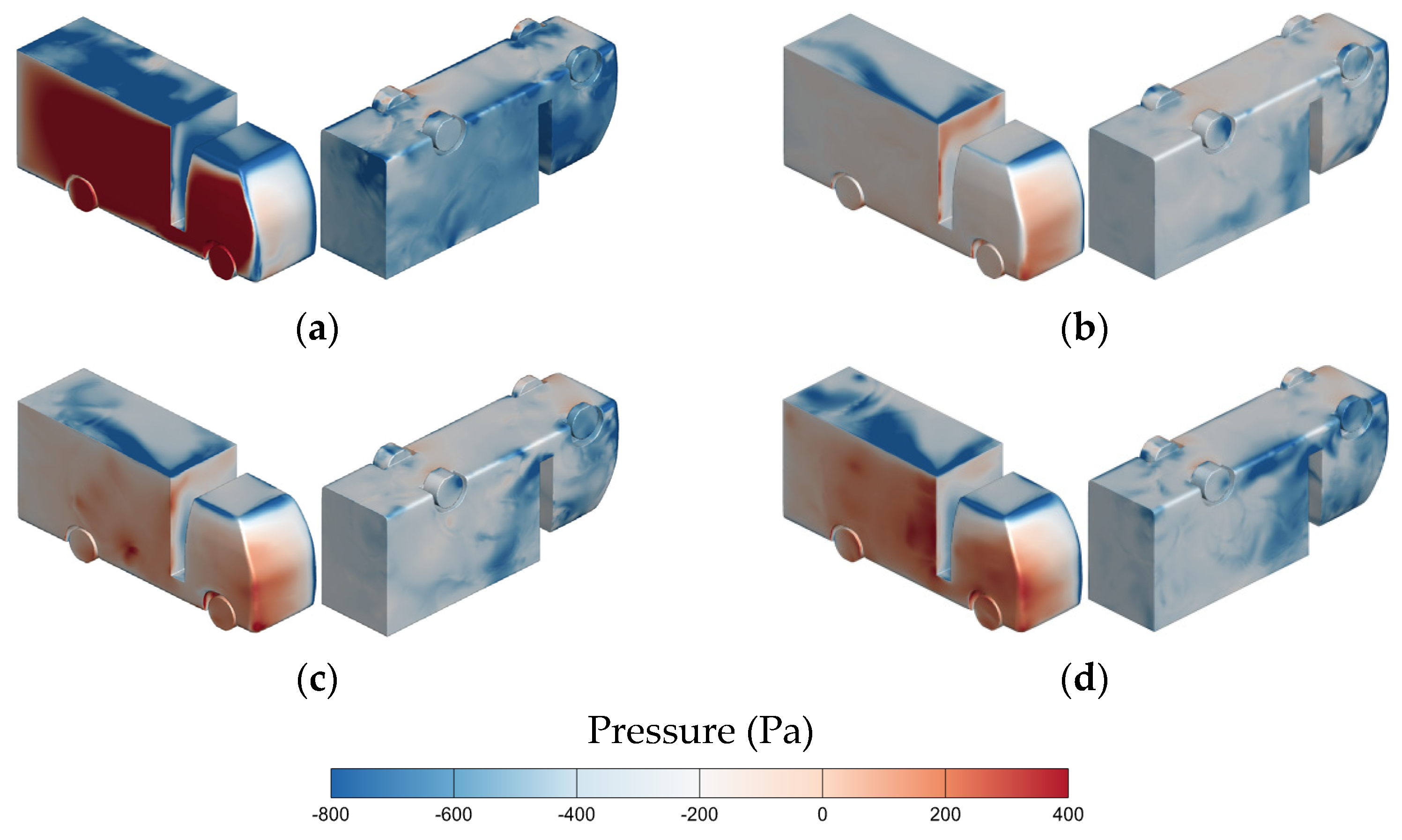
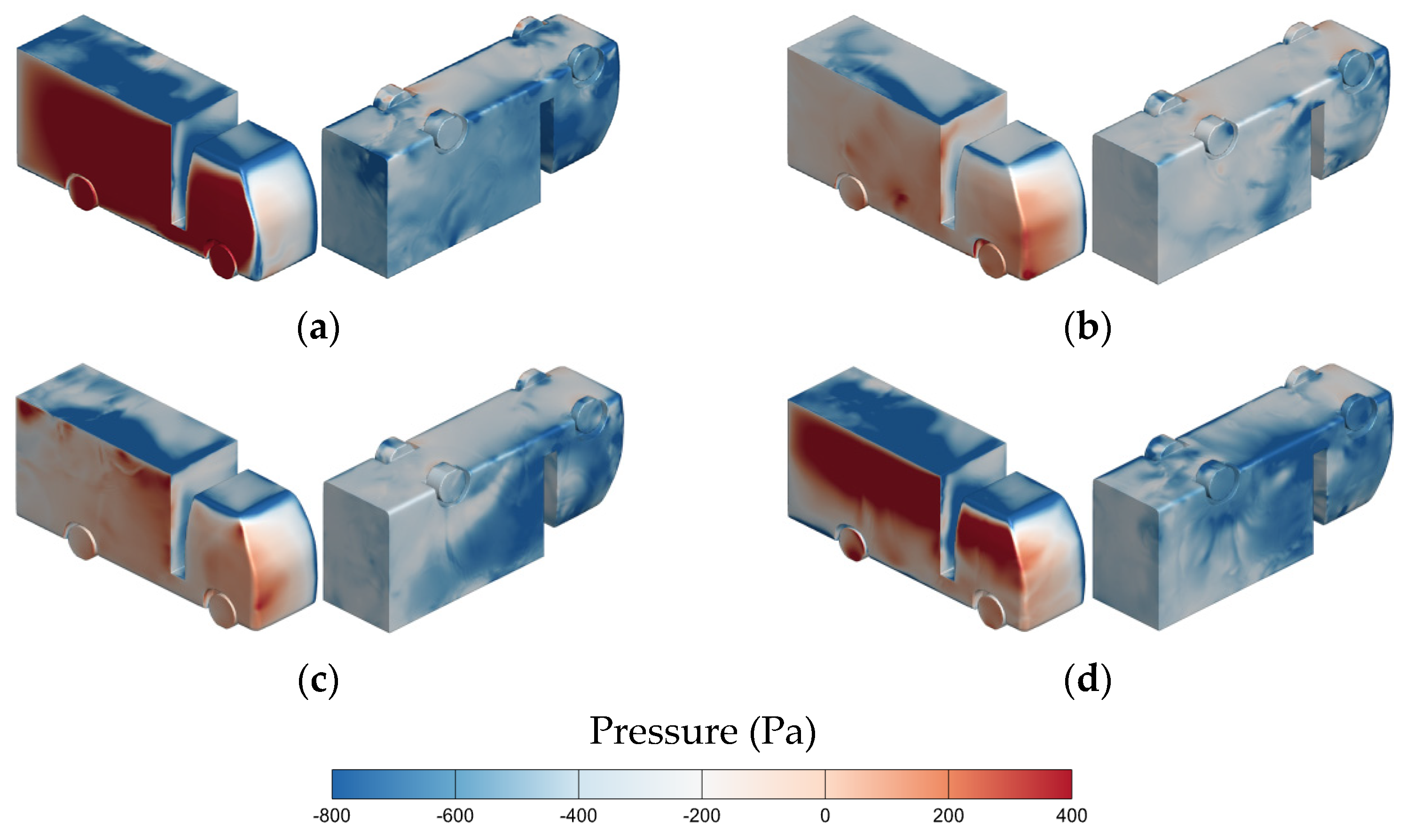

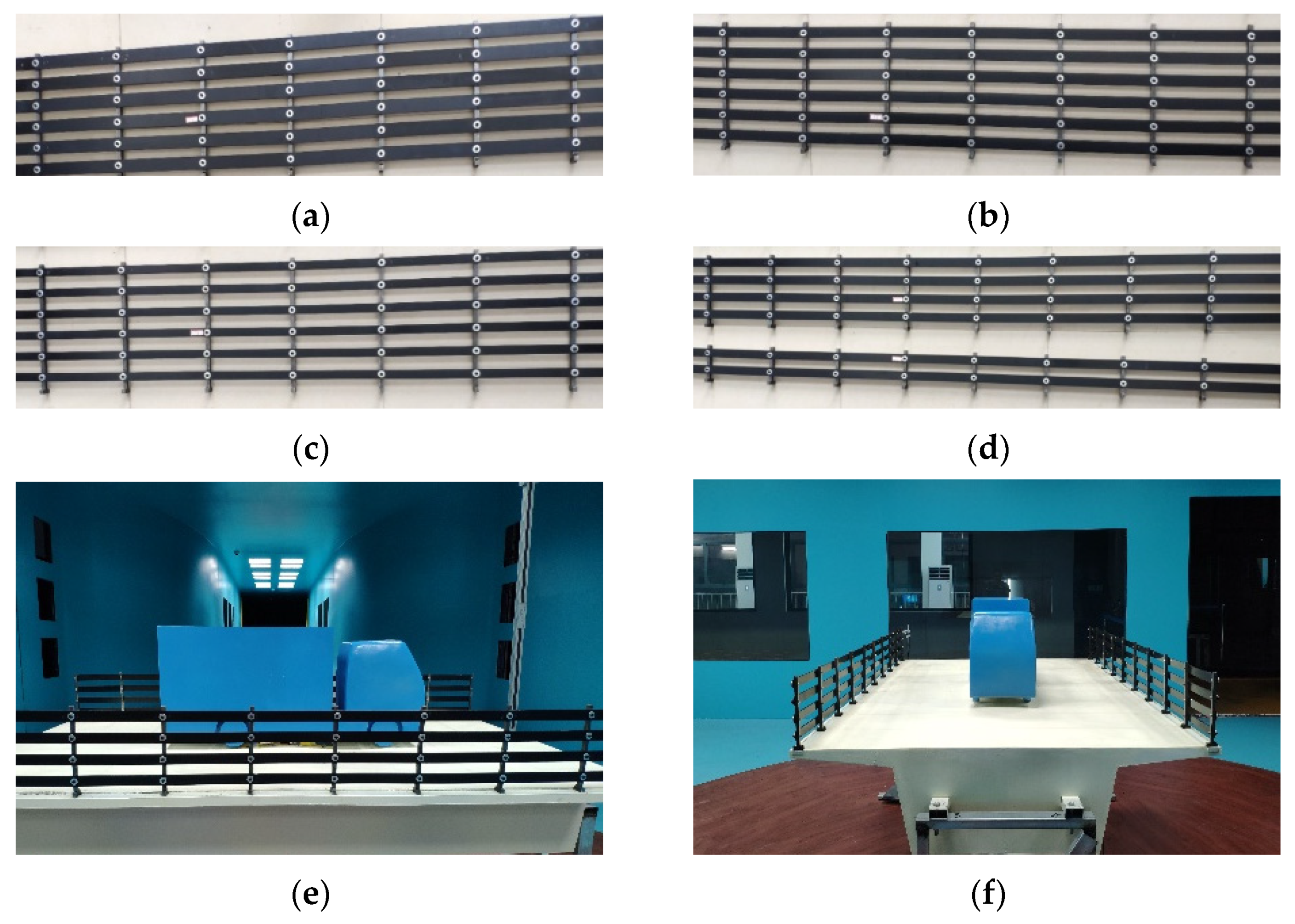
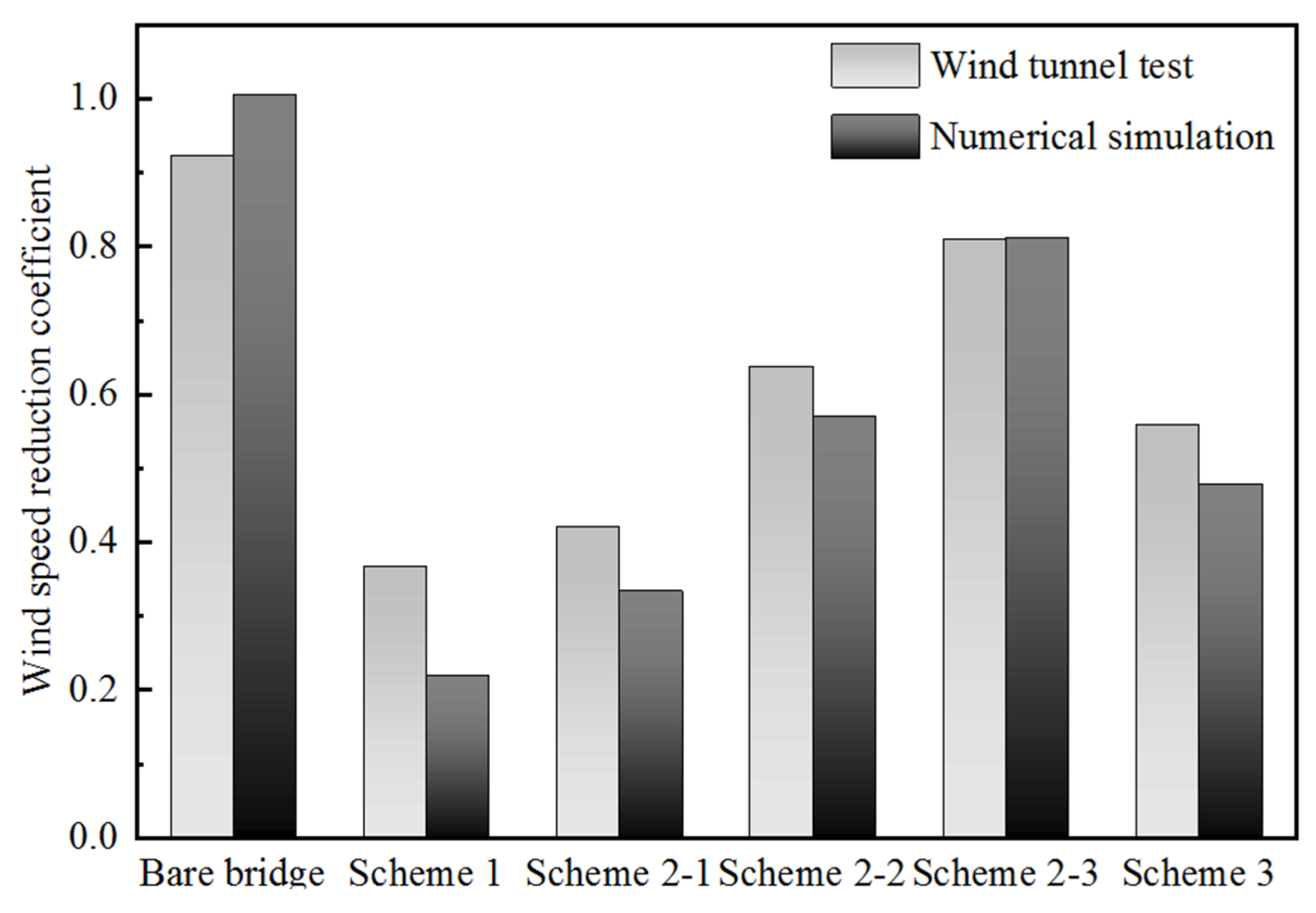
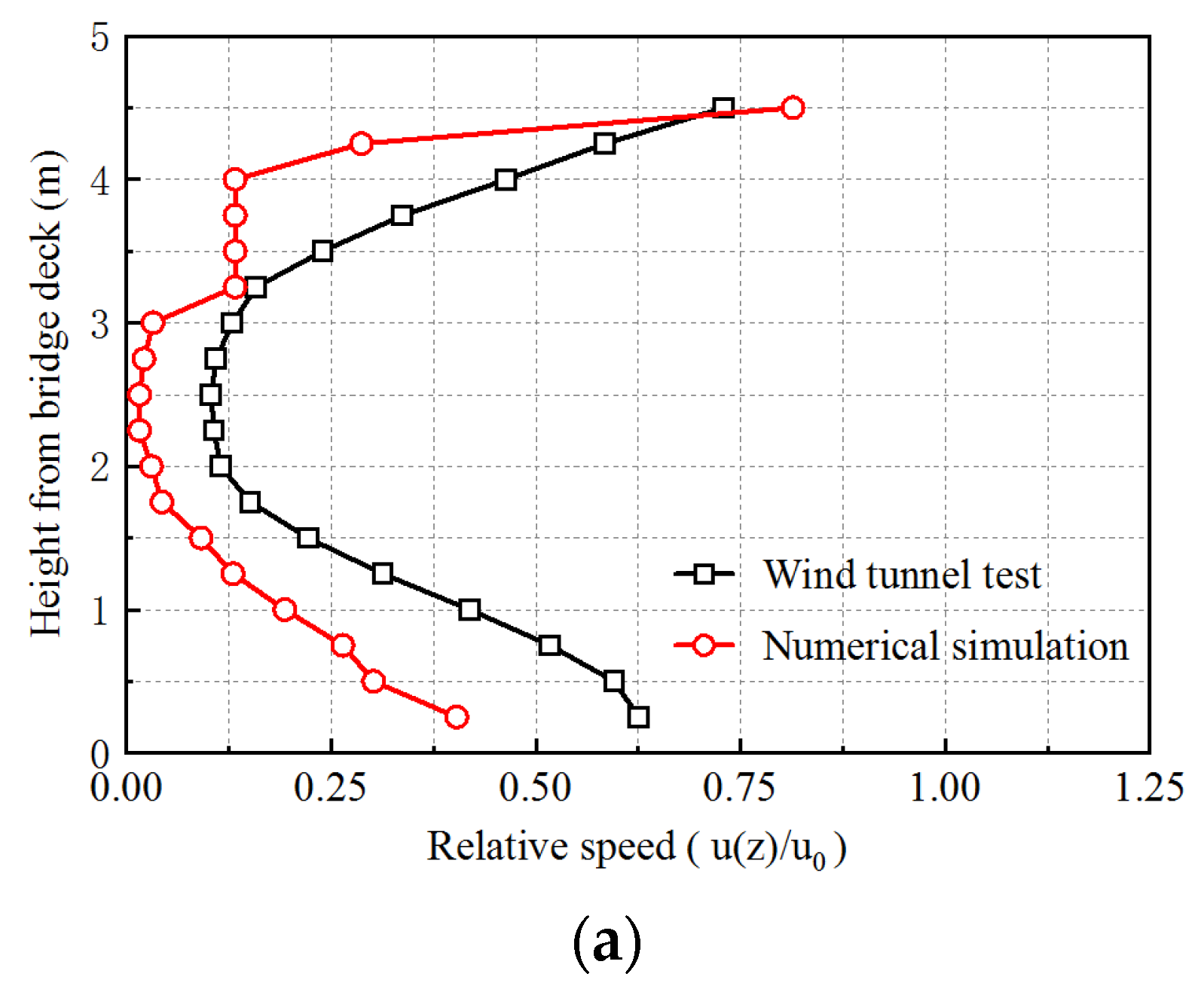
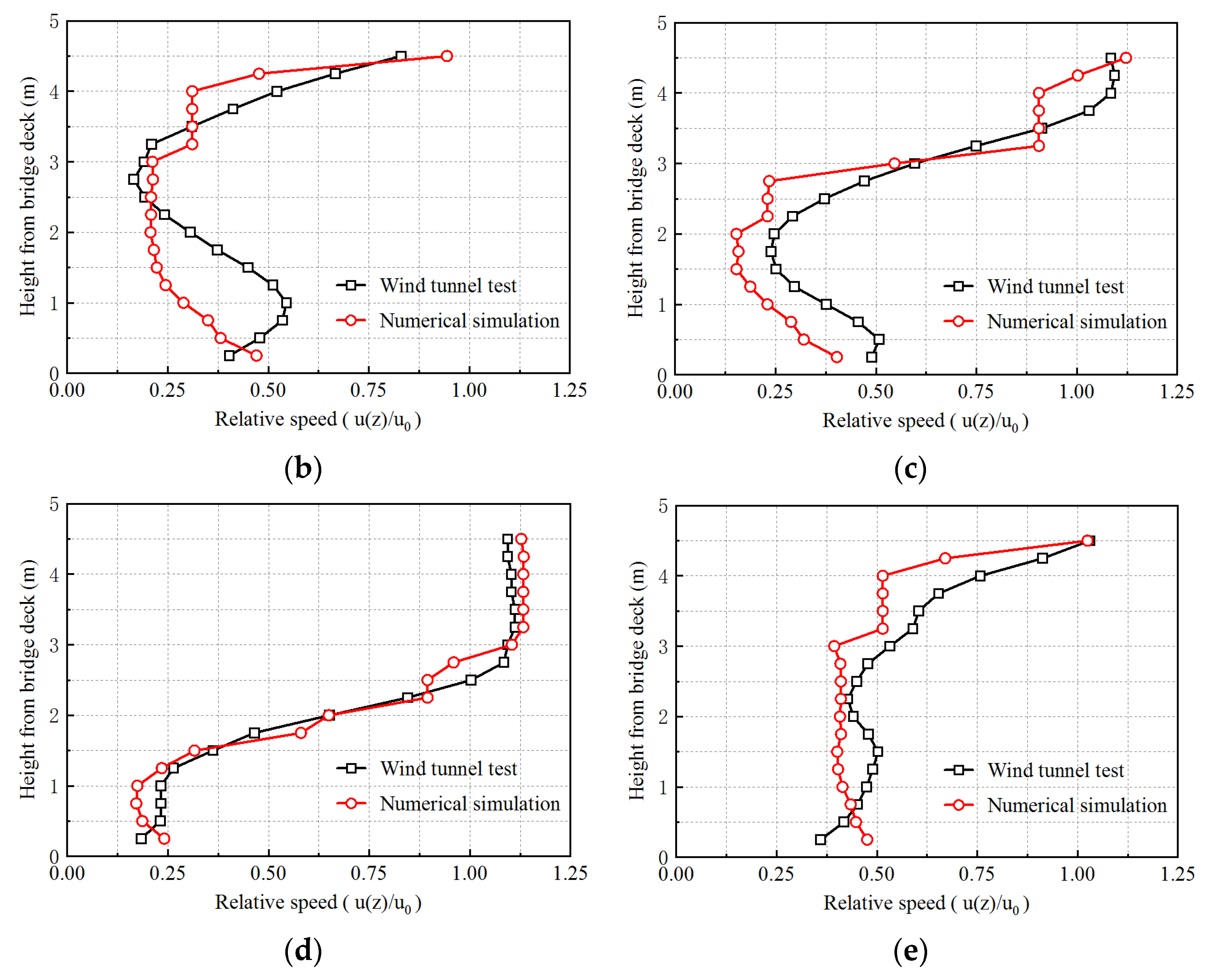
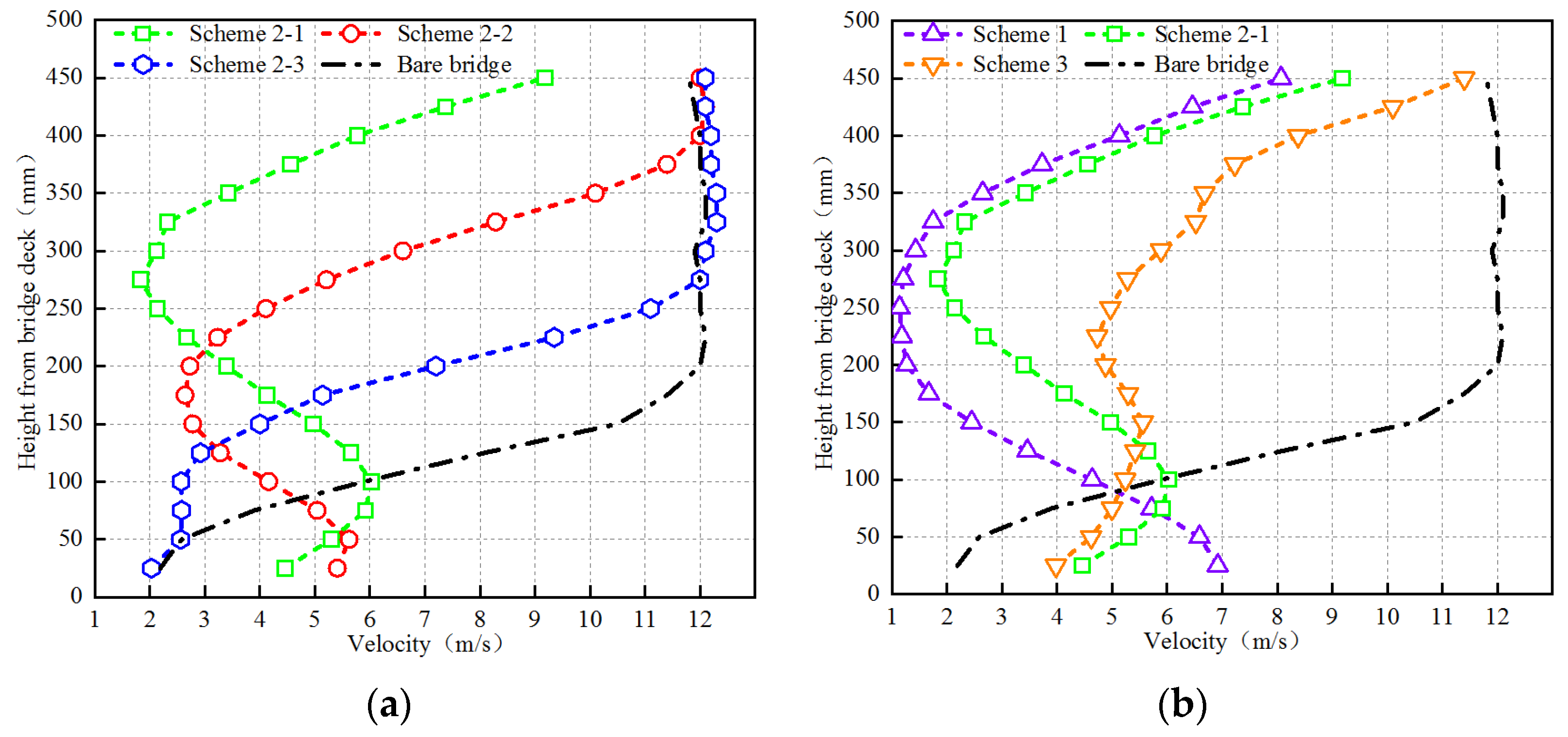
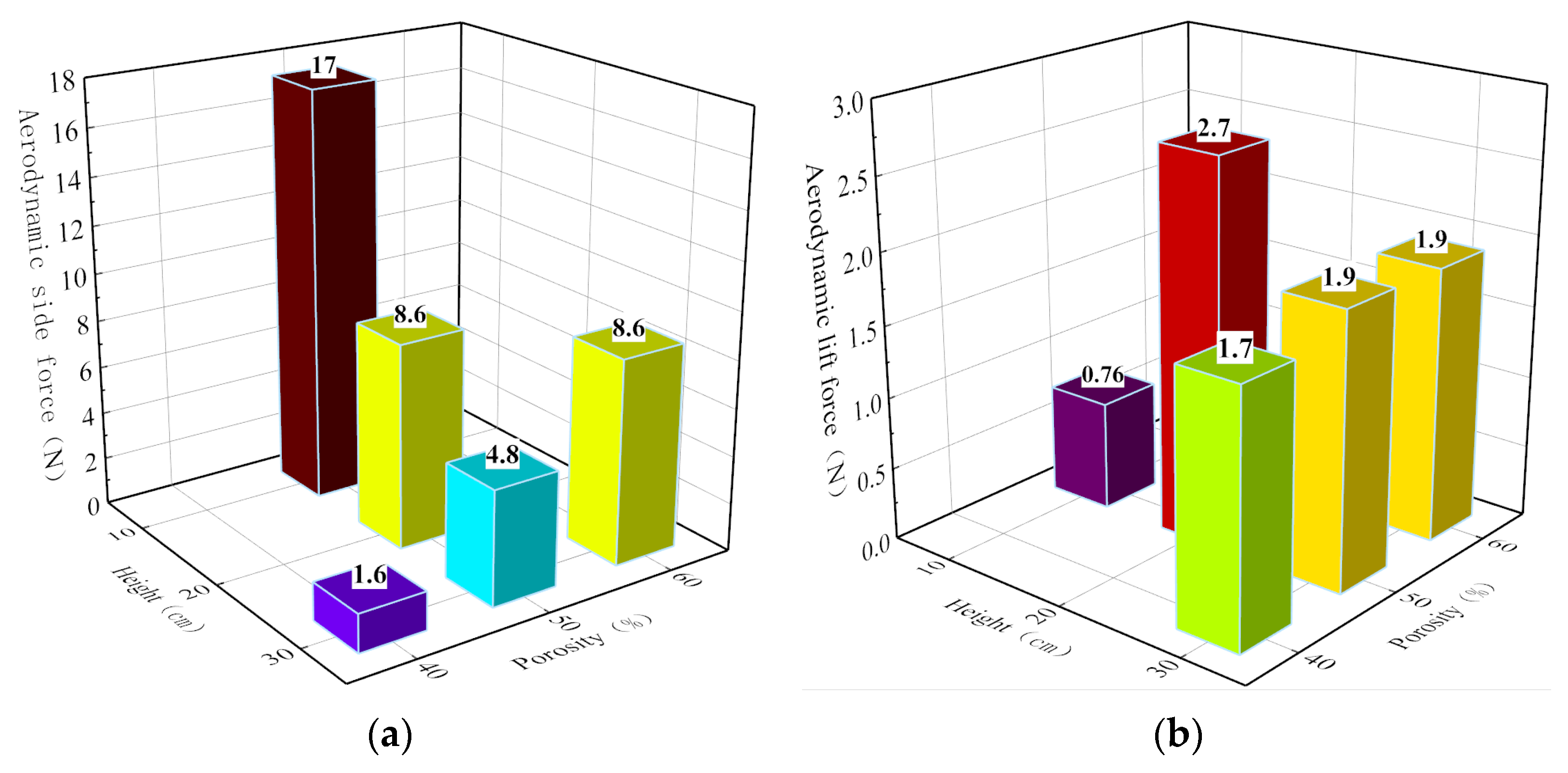


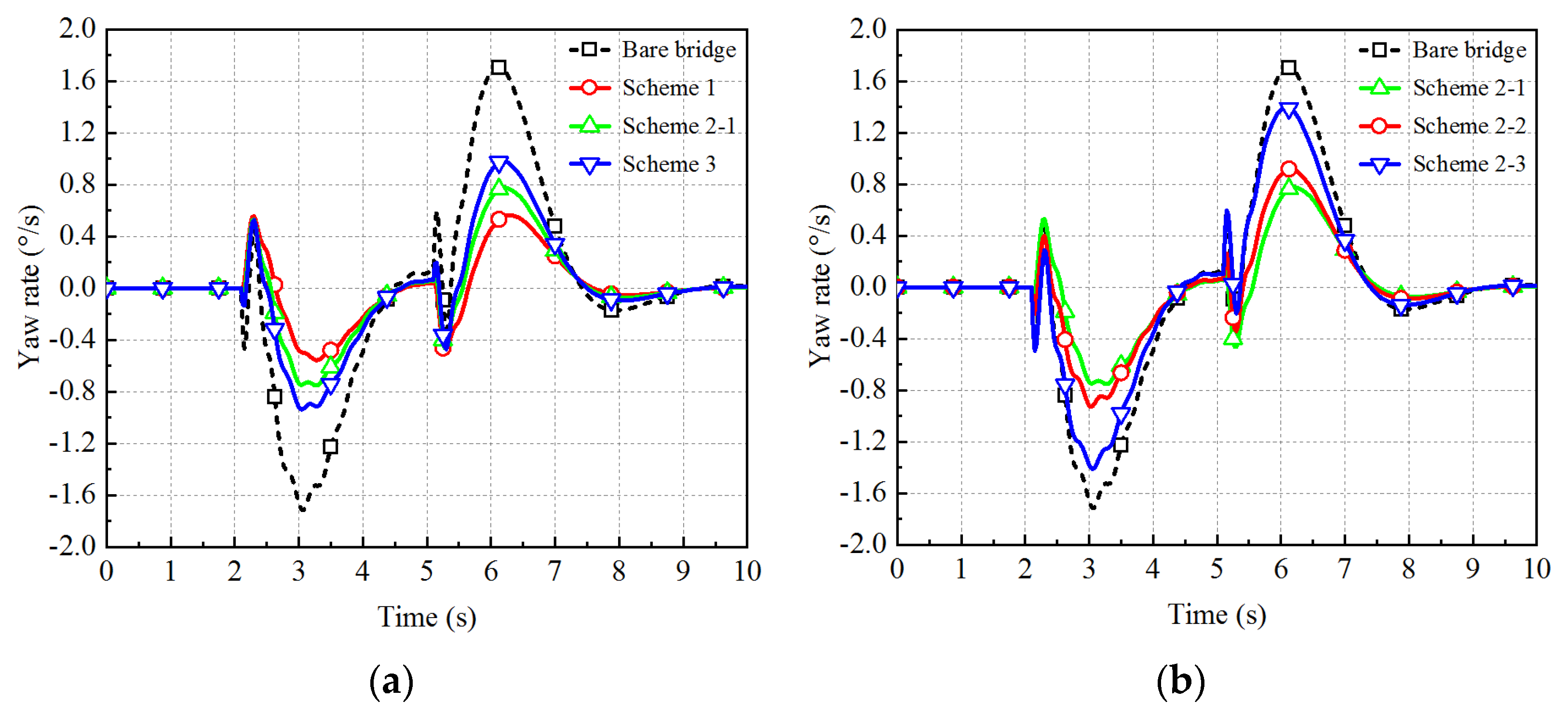
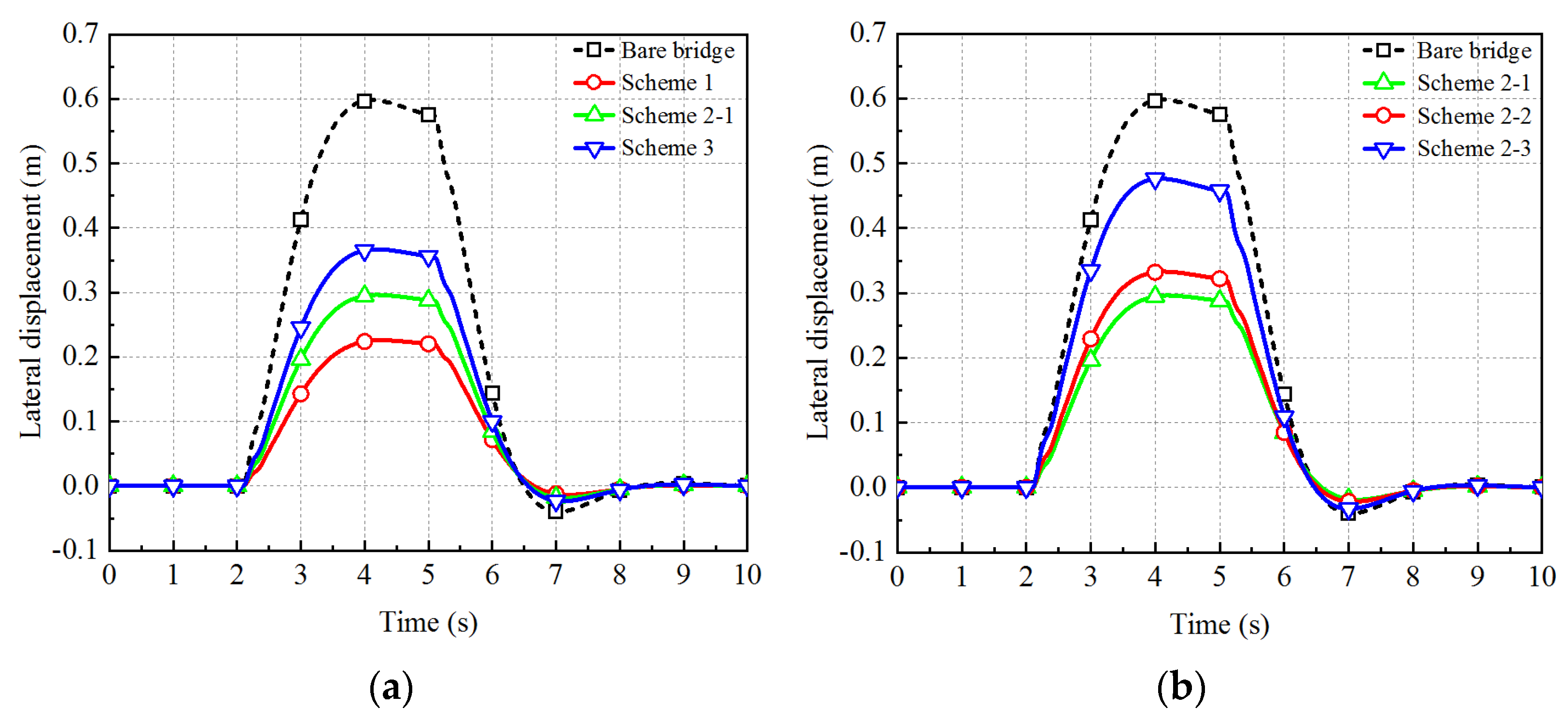
| Parameter | Unit | Value |
|---|---|---|
| Width of the van truck (w) | mm | 2400 |
| Height of the van trck (h) | mm | 3900 |
| Length of the van truck (l) | mm | 8500 |
| The distance from the center of mass to the front axis (lf) | mm | 2500 |
| The height from the center of mass to the ground (hz) | mm | 1620 |
| Stiffness of the front suspension (Ksf) | N/m | 250,000 |
| Damping of the front suspension (Csf) | N·s/m | 15,000 |
| Stiffness of the rear suspension (Ksr) | N/m | 700,000 |
| Damping of the rear suspension (Csr) | N·s/m | 30,000 |
| Roll moment of inertia for the van truck (Ixx) | kg·m2 | 2283.9 |
| Pitch moment of inertia for the van truck (Iyy) | kg·m2 | 35,402.8 |
| Yawing moment of inertia for the van truck (Izz) | kg·m2 | 34,802.6 |
| Unladen weight of the van truck (G) | kg | 4455 |
Publisher’s Note: MDPI stays neutral with regard to jurisdictional claims in published maps and institutional affiliations. |
© 2022 by the authors. Licensee MDPI, Basel, Switzerland. This article is an open access article distributed under the terms and conditions of the Creative Commons Attribution (CC BY) license (https://creativecommons.org/licenses/by/4.0/).
Share and Cite
Yuan, Z.; Xia, D.; Lin, X.; Lin, L.; Liu, Y.; Li, Y. Influence Mechanism of a Bridge Wind Barrier on the Stability of a Van-Body Truck under Crosswind. Atmosphere 2022, 13, 360. https://doi.org/10.3390/atmos13020360
Yuan Z, Xia D, Lin X, Lin L, Liu Y, Li Y. Influence Mechanism of a Bridge Wind Barrier on the Stability of a Van-Body Truck under Crosswind. Atmosphere. 2022; 13(2):360. https://doi.org/10.3390/atmos13020360
Chicago/Turabian StyleYuan, Zhiqun, Dandan Xia, Xiaobo Lin, Li Lin, Yufeng Liu, and Yuehan Li. 2022. "Influence Mechanism of a Bridge Wind Barrier on the Stability of a Van-Body Truck under Crosswind" Atmosphere 13, no. 2: 360. https://doi.org/10.3390/atmos13020360





